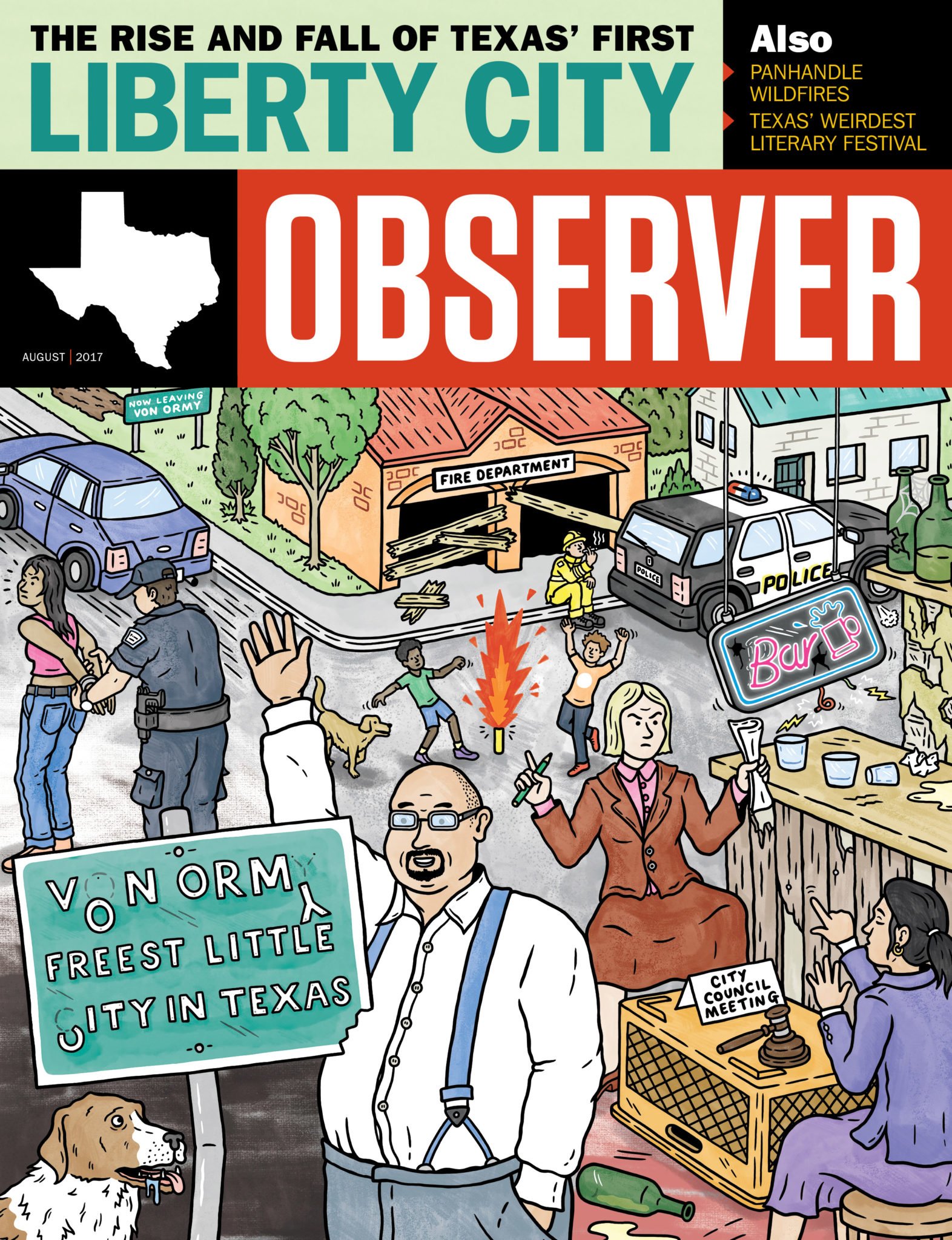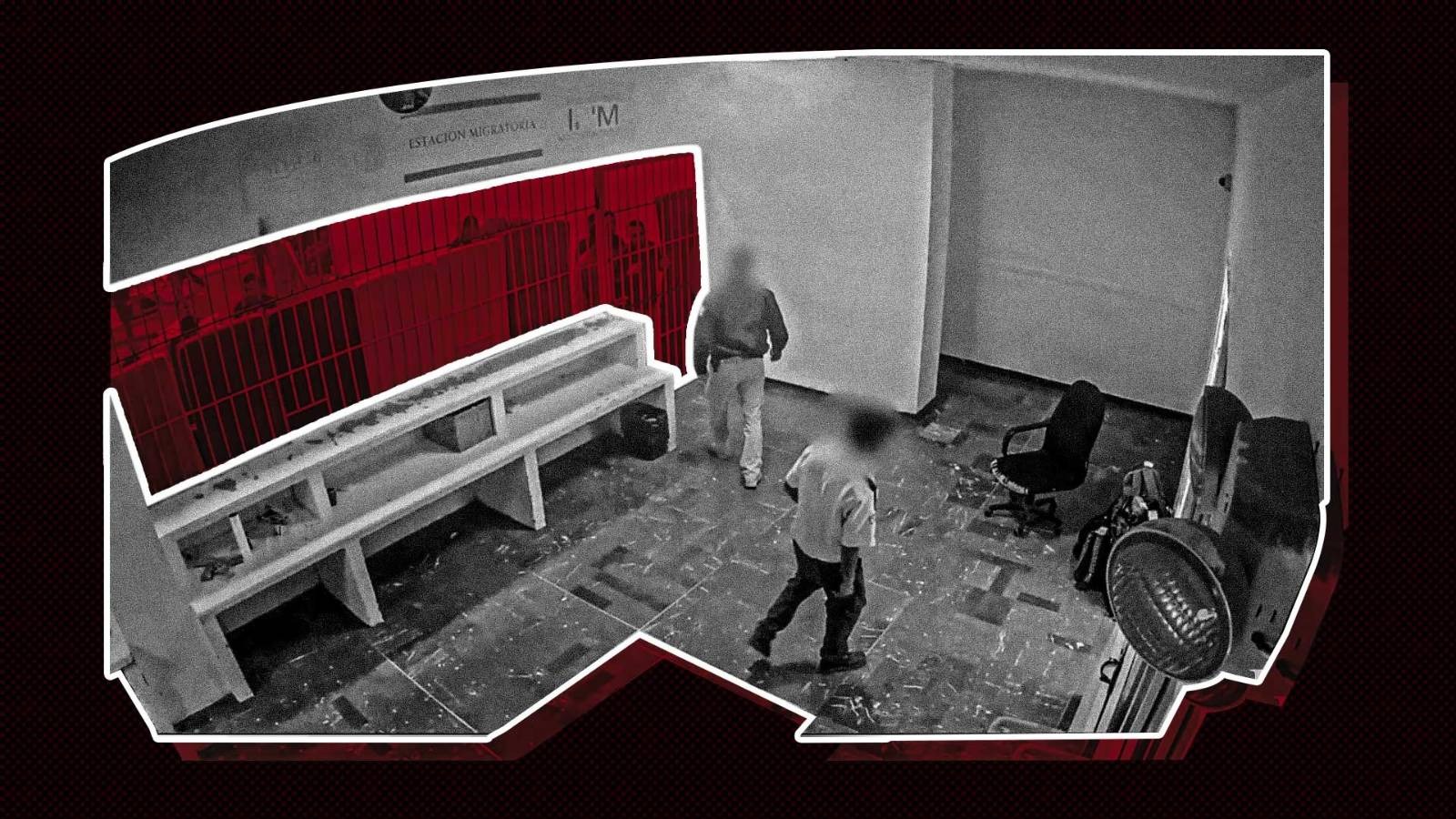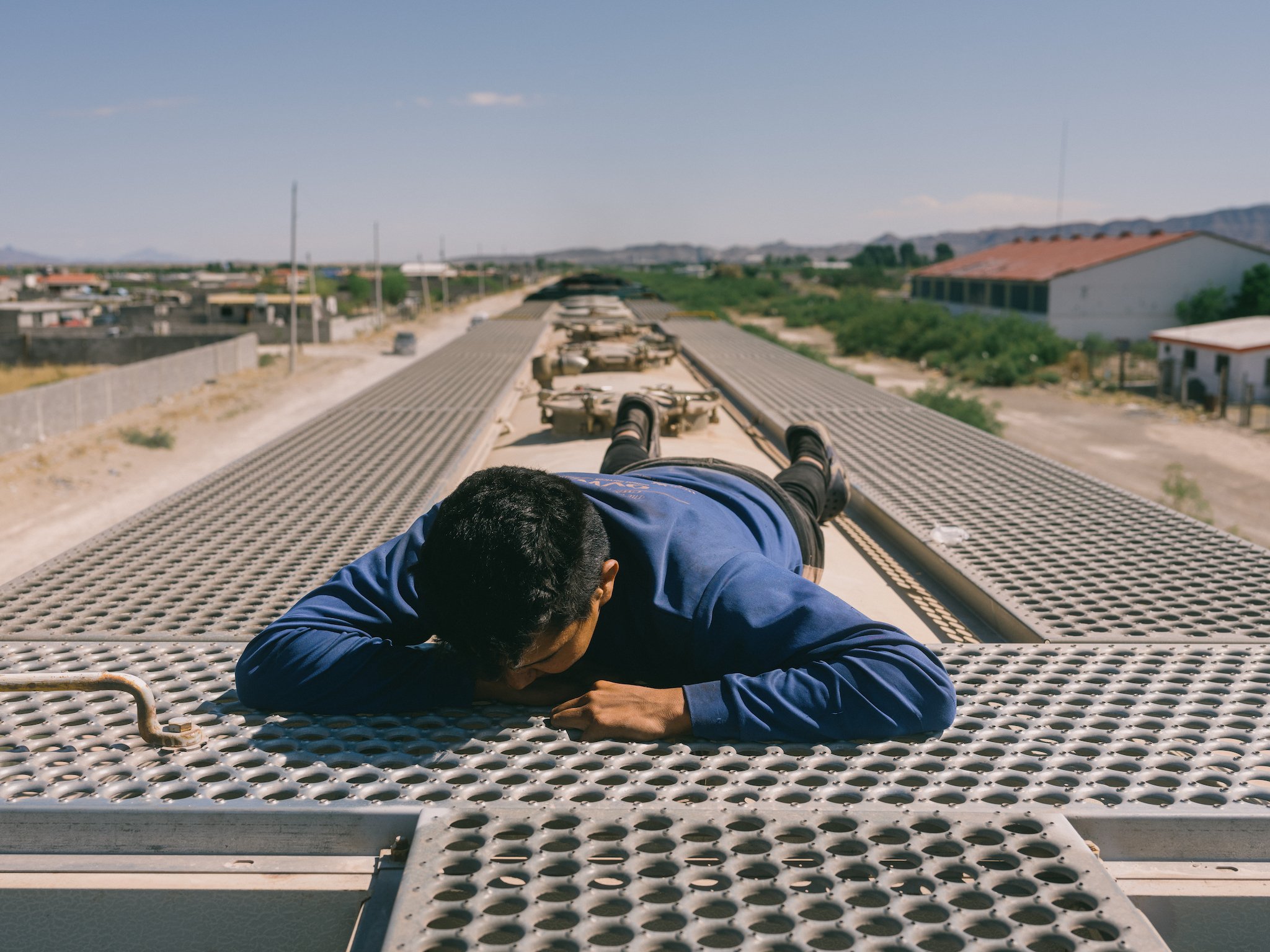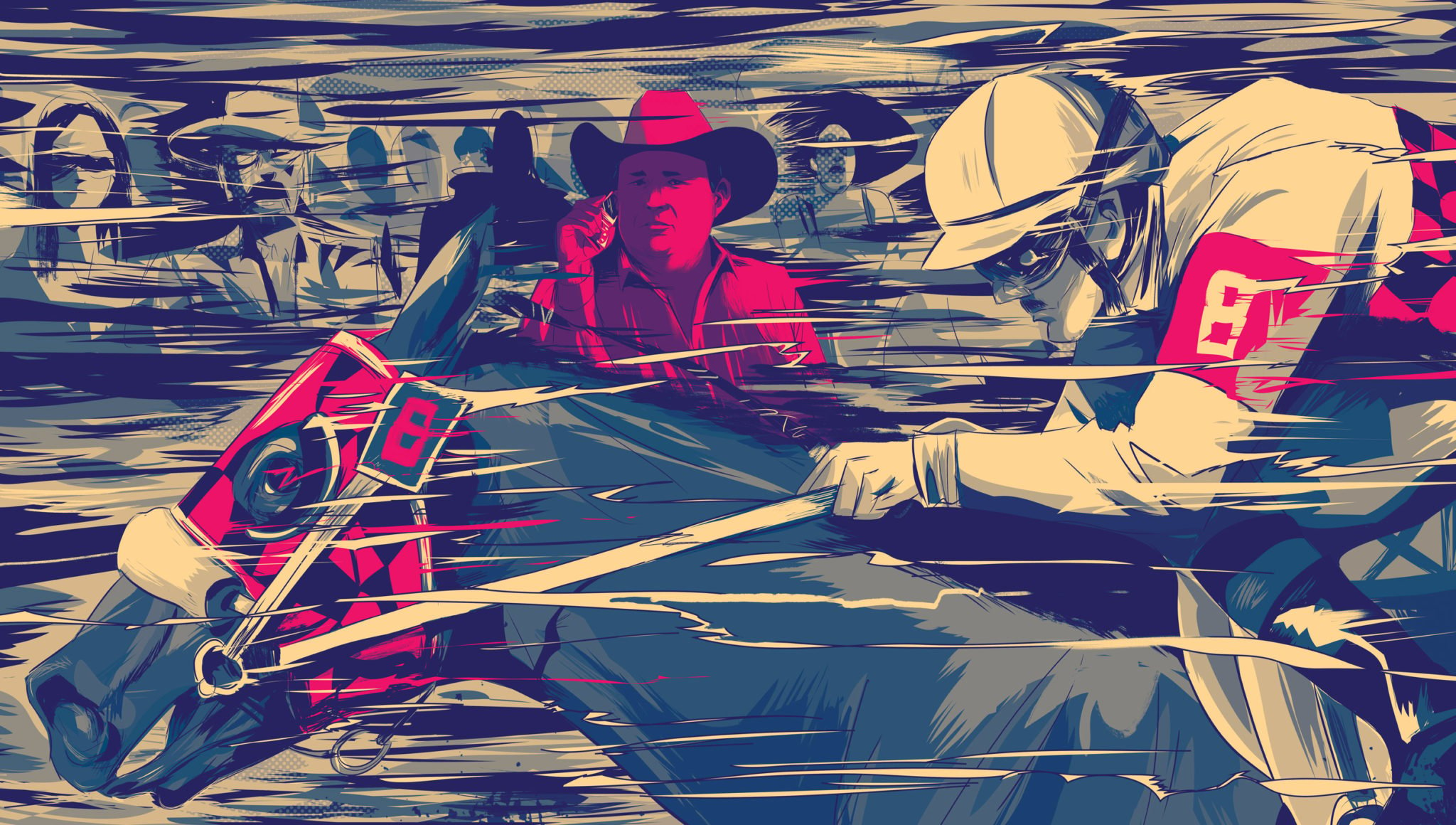
Stalking Horse
Inside a rookie FBI agent’s quest to take down a brutal drug cartel’s American horse-racing empire.
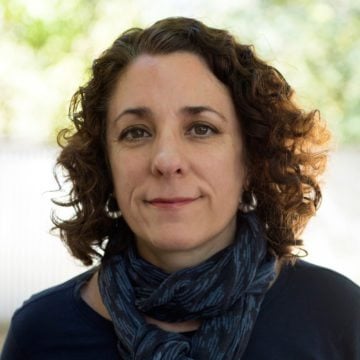
A version of this story ran in the August 2017 issue.
Stalking Horse
Inside a rookie FBI agent’s quest to take down a brutal drug cartel’s American horse-racing empire.
By Melissa del Bosque
August 7, 2017
In her new book, Bloodlines: The True Story of a Drug Cartel, the FBI, and the Battle for a Horse-Racing Dynasty, staff writer Melissa del Bosque follows two young Laredo FBI agents, Scott Lawson and Alma Perez, in their investigation to dismantle an American horse-racing dynasty controlled by Miguel Treviño, a ruthless leader of the Zetas drug cartel.
The excerpt below finds Lawson, a rookie and Tennessee transplant to Laredo, conducting undercover surveillance at an auction and race in Ruidoso, New Mexico. Lawson’s main target is José Treviño, the elder brother of Miguel and the front man for the horse-racing business.
With the help of Tyler Graham, a prominent racing insider, Lawson documents José’s purchases at the auction, critical evidence for the FBI and IRS’ money laundering investigation. Later, he watches with interest as one of José’s horses, Mr. Piloto, races for the $2 million purse in the All American Futurity, the Kentucky Derby of American quarter horse racing.
***
By the time Lawson had found out about the All American from Tyler Graham, almost every room in Ruidoso had already been booked. The race was a big deal for the small mountain town. The only room he could find was at a run-down Best Western for $280 a night. This hadn’t pleased his boss, David Villarreal, but he knew what was at stake, especially after their meeting with the DEA in Houston. For the first time, Lawson would be entering José’s world and could document who the players were, the front companies and the horses. He decided to ask Raul Perdomo, one of the Cuban agents who’d come from Miami, to help him out. To save money on the travel budget and to make Villarreal happy, they could also share the hotel room.
Lawson had already devised a cover story for them: If anyone asked, they’d say they had a rich friend back in Texas and they were speculating at the auction on his behalf.
Before they’d left Laredo, Lawson had asked Perdomo to do his best at playing the part of a rancher while they were in New Mexico. But Perdomo had a hard time denying his Caribbean roots. “Don’t worry, I’ll look redneck enough,” he joked, which didn’t exactly put Lawson at ease.
After they checked into their room at the Best Western, Perdomo pulled out of his suitcase a pair of pointy white boots and a purple shirt with a dragon emblazoned across the chest.
“Jesus,” Lawson said, surveying the colorful getup. “You can’t wear that Miami Vice shit to the track.”
“What’s wrong with it?” Perdomo said, looking wounded.
“Ah, forget it,” Lawson said.
He’d heard from other agents that José was a paranoid guy — someone who’d spent decades staying off law enforcement’s radar. And he suspected he’d be hypervigilant, especially while he was spending his brother’s money in New Mexico.
Early the next morning they drove over to the Lodge at Sierra Blanca, a resort and golf course where Tyler Graham stayed whenever he was in Ruidoso. Lawson felt a twinge of envy driving up to the front of the gleaming white resort, which made their room at the Best Western seem even shabbier. The parking lot was filled with expensive diesel trucks and fancy horse trailers.
Graham answered the door in jeans and a polo shirt. He was going golfing after their meeting, he said casually. Lawson was impressed, once again, by his ability to take a moment most would find stressful and compartmentalize it so that he scarcely broke a sweat. Two FBI agents in his hotel room was no big deal. Lawson and Perdomo each pulled up a chair and sat down, while Graham turned down the television.
Lawson wanted to know what they should expect and what to look out for in the coming days. Graham explained that the weekend would be devoted to the auctions, where buyers would be bidding on some of the most valuable racing bloodlines the industry had to offer. All of the big players would be there evaluating the upcoming crop of yearlings. The three-day weekend would culminate in the All American Futurity on Monday, which was Labor Day.
Graham showed them a dog-eared sales catalog for the upcoming auction and explained what hip numbers were. Each horse up for sale would have a hip number that corresponded to its entry in the catalog, along with a description of the year it was foaled, its pedigree and other traits. There were certain bloodlines that Graham knew José would be drawn to. This was because they were the most valuable, most expensive horses up for sale.
“Keep an eye out for these horses.” Graham flipped through the thick catalog and pointed out a handful of horses that José had told him he already planned to buy. Lawson wrote the names and hip numbers down in a small notebook he’d pulled from his back pocket.
“Here’s some others they will probably buy because they’re expensive,” Graham said, pointing to a few more entries in the catalog. Lawson and Perdomo leaned in closer to scrutinize the names of the yearlings, all descended from top sires, including First Down Dash, Corona Cartel and Mr. Jess Perry — all of them would probably go for tens of thousands of dollars at the auction. Lawson wrote down the hip numbers.
“Thanks for this,” Lawson said, closing the small spiral notebook and shoving it into the back pocket of his jeans. Graham nodded. “Sure,” he said.
“Once things get rolling, it will be too risky for us to meet up again,” Lawson said. “Better we text or phone.” He couldn’t bury the fear that they’d be spotted by José. It had started as a small nagging thought when they’d landed in El Paso the day before and grown exponentially the closer their rental car got to Ruidoso. Maybe it would be Perdomo’s purple dragon shirt, or Lawson and his camera, that would suddenly draw his suspicion. He’d heard from other agents that José was a paranoid guy — someone who’d spent decades staying off law enforcement’s radar. And he suspected he’d be hypervigilant, especially while he was spending his brother’s money in New Mexico.
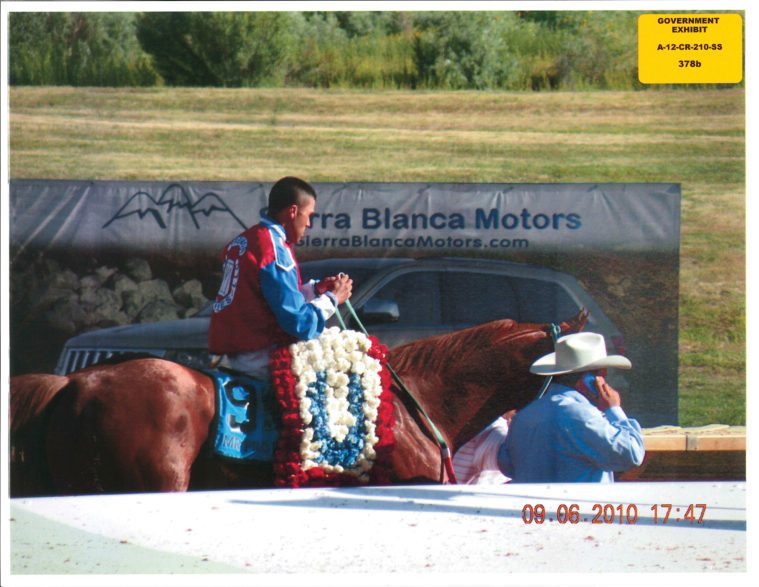
The Ruidoso Downs racetrack sat in a green valley dotted with juniper scrub, surrounded by pine-tree-covered mountains. The sky was a vibrant blue, but the heat wasn’t humid and suffocating like it was back in Laredo. Much to his surprise, when they got to the track, Perdomo blended in better than Lawson. He didn’t have to say, “I told you so.” The grin on his face said it all. Some of the Mexican men were decked out in the latest in narco bling: massive diamond watches, Ed Hardy jeans with rhinestone-studded pockets, and brightly colored cowboy boots that curled up at the tip. Lawson wondered whether they worked for Miguel or another cartel. They were outshone only by the wealthy women from Texas in their long, leather-fringed jackets with matching custom cowboy boots and piles of silver Southwestern jewelry.
The agents spent the first day milling around the sales pavilion just east of the racetrack. The pavilion looked like an oversized barn made of corrugated steel surrounded by long rows of stalls where the horses were kept. Inside was an indoor amphitheater where ranchers sat in clusters bidding on the horses led before them in the sales ring. A portly auctioneer in a black cowboy hat sat on an elevated stage behind a console at the rear of the ring, calling out each horse’s name and hip number in a droning baritone punctuated by the sharp crack of his gavel when a horse was sold. The bidding was a subtle dance, and it was difficult for Lawson to decipher who was doing what. It was up to three older men in Western shirts who paced up and down the aisles scrutinizing the crowd to determine whether a blink of an eye was a bid or an involuntary muscle spasm. When one of the men had a bidder locked in he’d whoop out a loud “Hep!” and the auctioneer would register the bid: “I’ve got 150, 150, how about 200?”
Carlos Nayen was easy to spot near the edge of the sales ring: He wore a pink shirt unbuttoned nearly to the navel and topped with a gold chain. José, in a white cowboy hat, sat nearby, sizing up each horse. But Lawson noticed he never bid.
No one would ever guess, in his jeans and beat-up cowboy boots, that he was the elder brother of two wealthy cartel leaders. He didn’t gravitate toward flashy jewelry or clothes like Nayen. He’d been good at being invisible. But Lawson knew that as his brothers had become more notorious, José had increasingly come under scrutiny. Every time he crossed the bridge from Nuevo Laredo into Laredo, he was held for hours by Customs and Border Protection agents and questioned about his brothers.
Lawson took a seat on the other side of the ring so he could get a good angle with his camera, while Perdomo went outside to find the stables where Fernando Garcia was keeping some of the cartel’s horses. In his gray cowboy hat and boots he hoped he looked like just another horseman looking to buy. He aimed his camera toward the ring as if he were taking pictures of the horses. Whenever José and Nayen looked away or were distracted he’d take a picture. As the camera clicked he could feel his heart beating in his chest like a kick drum. Graham stood near Nayen with the open sale catalog in his hands. Lawson knew he could count on Graham’s poker face if he spotted him in the crowd.
Each time he bid, Nayen would take a photo with his cellphone of the neon board flashing the sales price, then start furiously texting. He scarcely looked up from his BlackBerry phone. Lawson imagined he was texting Miguel the sales prices. He snapped more photos… click, click, click. Suddenly, José turned and seemed to be staring straight at him. Lawson involuntarily sucked in his breath. The worst he could do was panic and bolt from the amphitheater. Quickly he feigned interest in the catalog he’d grabbed at the entrance. He was already beating himself up for blowing the surveillance. He imagined Villarreal regretting he’d sent a rookie instead of a seasoned agent. He thumbed through the pages for a few minutes, then looked up again. Graham was consulting with José over something in the auction catalog and José appeared entirely engrossed in whatever they were discussing. Lawson hoped he hadn’t been made. He’d phone Graham as soon as he got the chance. Having had enough excitement for the afternoon, he quickly packed up his camera, a feeling of dread in the pit of his stomach, and headed for the exit.
Suddenly, José turned and seemed to be staring straight at him. Lawson involuntarily sucked in his breath. The worst he could do was panic and bolt from the amphitheater.
His anxiety didn’t ease until Graham finally returned his call a couple of hours later. Much to his relief, Graham told him that José had never spotted Lawson across the ring. Graham was sure of it, he said. So their surveillance hadn’t been compromised after all. And he’d been so quick to assume the worst.
When Labor Day came around, the stands overflowed with spectators for the race everyone had been waiting for. Lawson and Perdomo pushed their way up to the railing to watch the slender jockeys on their mounts warming up on the backstretch for the All American Futurity. The jockeys clung to their horses as they sprinted down the track in perfect aerodynamic union. To Lawson, they seemed to almost glide over the backstretch. Before the race began, they made a quick pass through the indoor betting area crowded with bettors and people lined up for drinks at the kiosks. They made some $3 and $5 bets to look busy. Lawson had learned just enough from Graham about the top racing bloodlines that he felt he could make an educated gamble on the All American. He figured if he put his money on a few win, place and show bets on the horses with the best pedigrees, he would at least come out even. He put $3 down on Mr. Piloto, the biggest long shot in the race. The large sorrel stallion had a first-rate pedigree but hadn’t exactly lit up the track, scoring one of the slowest qualifying times in the history of the All American and ranking last among the 10 horses that had qualified.
Graham had told him that qualifying for the 440-yard race was notoriously grueling. More than 400 horses had competed over three days in August for one of the race’s 10 slots. Horses that won a coveted place in the All American could claim to be some of the world’s fastest. A world speed record had been set during the 2006 race when a horse called No Secrets Here had demolished the 440 yards in less than 21 seconds, clocking a speed of 43 miles per hour.
Half of the $2 million purse would go to the winner, and the rest would be divvied up among the other nine horses according to how they placed. Winning the Futurity was a dream lusted after by every jockey, horse owner and trainer in the industry. There were racing veterans who’d worked for decades to qualify for the All American but still hadn’t succeeded. For José’s Tremor Enterprises, which had existed only little more than a year, to have a horse in the race was viewed by most as an incredible stroke of good fortune. They had no idea, of course, that luck had nothing to do with it. José had simply run several high-dollar horses in the trials under various straw owners and companies, until one of them had qualified. It was the law of averages, no more and no less. “José’s no great horseman,” Graham had told Lawson. “He just buys the best.”
He’d already texted Lawson to let him know where he’d be during the race — standing with José and the others on the inside of the track near the scoreboard and the finish line. Lawson had made sure he was sitting in the bleachers directly across from them so he’d have a clear view. He pointed the camera’s telephoto lens toward the finish line. He could see Graham in dark sunglasses standing next to José in his white cowboy hat and Nayen, who wore a black suit, probably Italian and expensive. It was five in the afternoon and race fans had been drinking cheap beer and tequila all day under the sun. Everyone, including Lawson, was sunburned and ready for the race to finally begin.
By studying the rise of Mr. Piloto, he was starting to piece together how the organization worked. In the August qualifying trials for the All American, José had run at least 10 horses under various limited liability companies. Mr. Piloto had been owned by Garcia Bloodstock and Racing, which belonged to Fernando Garcia, who had started the LLC just a few months before the race. The 29-year-old had several expensive horses under his name, including Mr. Piloto. It had been Ramiro Villarreal who bought the racehorse for $81,000 at a Heritage Place auction back in September 2009. The horse’s name had been Maverick Perry before Nayen had changed it.
After Mr. Piloto qualified at the trials for the All American, the ownership was transferred to José’s Tremor Enterprises, an LLC he’d formed after he acquired Tempting Dash. The LLCs were easy to incorporate — all it took was $300 and filling out a few forms with the Texas secretary of state. José was shuffling the horses from one LLC to another, and once a horse won a race and became more valuable, it became property of Tremor Enterprises LLC.
As Lawson and Perdomo waited for the All American to start, Lawson tried to reposition himself more comfortably on the hard aluminum bench — no easy task with a Glock pressing up against the inside of his boot. He noticed that most of the spectators sitting around him in the crowded bleacher seats were Mexican or Mexican American. The Mexicans had brought their love for racing with them from the rural countryside and the dirt tracks in northern Mexico and the Gulf Coast. Up above the bleachers, in the air-conditioned Turf Club and VIP boxes with the premium views, many of the faces were still white. But they were getting older; their children didn’t have the same fire for horse racing: too much risk, too little gain. It was no secret the future of U.S. quarter horse racing was Latino. Lawson noticed that even Tyler Graham spoke fairly decent Spanish. Graham had even picked up some Portuguese after a recent trip to Brazil, where the quarter horse industry was growing. Horse racing, like almost everything else, had to become a global enterprise to survive.
The bugler played the Call to Post and the horses filed down the red dirt track toward the starting gate. Excitement rippled through the crowd and people cheered as the horses passed by. Mr. Piloto wore a red, white and green nylon blinker hood to keep his eyes focused on the track. In the middle of the hood an eagle grasped a snake in its beak, the symbol of the Mexican flag. “Hecho en Mexico” was written above it. Lawson had heard that Miguel resented how the rich white people in Dallas had treated him and his family. No doubt it would give him satisfaction if Mr. Piloto won and the gabachos up in the VIP boxes would know the champion’s owner was Mexican.
Lawson could barely see the horses at the starting gate from where he sat near the finish line. Quarter horses sprinted so fast, if he looked away for a few seconds, he’d miss the whole thing. A 440-yard race, which was a quarter mile — the distance for which the horses were famously named — could be over in less than half a minute. The crowd hooted and yelled for the race to begin. Lawson heard the clap of the metal starting gates fly open and the distant rumble of hooves thundering down the track. He could see the other horses bunch together toward the inside rail as Mr. Piloto veered hard to the outer edge. The horse was so close to the railing, Lawson could hear the crack of the jockey’s whip and see clumps of dirt flying up from the stallion’s hooves as Mr. Piloto tore down the track. Toward the finish, the horses clustered together in a blur of bright jockey silks and horseflesh. When they crossed the finish line it was impossible to tell which horse had won. Confusion mounted as the racing stewards waited for the photo finish to be analyzed. After a handful of awkward minutes they finally made their call — Mr. Piloto by a nose.
José, Nayen and several others around them vaulted over the railing and onto the track, rushing toward Mr. Piloto and his jockey, Esgar Ramirez, as they took a celebratory turn in front of the spectators. Lawson snapped a photo as José took off his cowboy hat, looked up at the sky and made the sign of the cross. Then he dialed his cellphone, no doubt calling his brother in Mexico. Lawson snapped more photos as José, who was still on the phone, took the reins of Mr. Piloto and led him toward the winner’s circle. There, Garcia hugged José. Here were the seller and buyer of Mr. Piloto hugging one another in the winner’s circle. Lawson wondered what Garcia had to celebrate. He’d just sold Mr. Piloto for next to nothing, and the horse had won a million dollars.
Lawson noticed Nayen off to the side texting with the same intensity as the day before. It was clear to Lawson by the chatter around him that Mr. Piloto’s win had taken everyone by surprise. The odds of the horse winning had been 22-1. Even track veterans who accepted that racing was a fickle business, full of unpredictable twists and turns, couldn’t quite believe it. Mr. Piloto’s win had not only been the most lucrative, but also accomplished against the longest odds in All American history. Lawson made his way over to the betting window and collected his money.
(Illustration by Ryan Inzana)
Adapted from Bloodlines by Melissa del Bosque. Copyright © 2017 by Melissa del Bosque. Reprinted with permission of Ecco, a division of HarperCollins Publishers.
This book excerpt appears in the August 2017 issue of the Texas Observer. Read more from the issue or become a member now to see our reporting before it’s published online.
